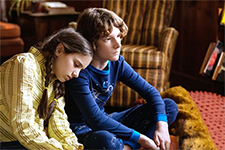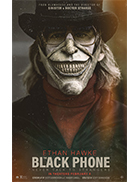The Black Phone
|  Set in the northern suburbs of Denver in 1978, The Black Phone is as much about its time and place as it is about a child-snatching serial killer and his most recent adolescent abductee. Not since Richard Linklater’s Dazed & Confused (1993) has there been a contemporary film quite so enthralled with and attuned to the specific cultural and material details of the Carter years. From the Bad News Bears-esque baseball uniforms in the film’s opening scene, to the glass soda bottles, pinball machine in the corner convenience store next to racks of Starlog magazine (Fangoria not yet having been published), Davey and Goliath on the 13-inch television screen, and The Edgar Winter Group and Pink Floyd on the soundtrack, The Black Phone is awash in the sights and sounds of the late ’70s. All those historical details certainly add a level of pleasure for those of us who grew up in the era, but it is also critical to the film’s plot and the presence of a black rotary telephone. The film’s protagonist is a thin, junior high kid named Finney (Mason Thames), who lives with his precocious younger sister, Gwen (Madeleine McGraw), and their alcoholic, abusive widower-father Terrence (Jeremy Davies). Their suburban enclave is in the midst of being terrorized by a series of abductions, the unseen perpetrator of which is whispered about as “The Grabber.” In one of the film’s most unsettling visuals, the abduction of two kids is depicted via a slow fade to black as they unknowingly approach the Grabber, who moves about in a black van and, for a while, is only seen in the out-of-focus distance, which gives him an air of supernatural menace. As it turns out, he is decidedly human, embodied by Ethan Hawke in a creepy-weird performance that is done largely behind a series of leering and frowning devil masks that were designed by none other than Tom Savini, the make-up effects artist who all but defined the splatter film in the 1970s and ’80s. Finney becomes the Grabber’s sixth victim when he is snatched off the street and drugged, awakening inside a large, soundproof, concrete lined basement. The only things in the room with him are a toilet, some rolled-up carpets, a mattress and box springs bolted to the floor … and the titular black telephone, which is attached to the wall and has had its wires cut. Its exact reason for being there is never quite explained, and the Grabber tells Finney in his raspy-scary voice that it hasn’t worked since he was a child. But, Finney soon learns that it does work, just not in the way he might have expected. As it turns out, the phone is a conduit for the ghosts of the Grabber’s previous victims, including Finney’s friend Robin (Miguel Cazarez Mora), to talk to him and give him suggestions for how to escape. Some of these seem impossible, such as the suggestion that he dig a hole in the ground to go under the foundation, while others are tantalizingly possible. However, frustration after frustration pile up, punctuated by random visits from the Grabber in one of his unsettling masks, his presence foretold by his echoing footsteps coming down the stairs and then the metallic groan of the huge, soundproof door swinging open. When we are not trapped in the basement with Finney, awaiting what is sure to be an awful death, we follow Gwen as she attempts to find him. Like the black phone, Gwen has a supernatural gift: the ability to see things in her dreams. Apparently, her mother had this gift, too, and it led to her demise, which is why her father is so violently insistent that it isn’t real. But, we know that it is real, enough that two police detectives (E. Roger Mitchell and Troy Rudeseal) are willing to track her down and see what she might know. Thus, the clock is ticking, moving toward one of three possible outcomes: Gwen and the police find Finney before the Grabber kills him, Finney escapes with the help of the previous victims’ ghosts, or the Grabber kills him. The fact that any one of these possibilities has genuine merit is testament to the film’s overall effectiveness. Director Scott Derrickson is certainly no stranger to horror, having built much of his career on unsettling, spiritually minded horror-thrillers (2005’s The Exorcism of Emily Rose, 2012’s Sinister, 2014’s Deliver Us From Evil) that manage to transcend their more derivative qualities to work of their own accord. His most recent film was Marvel’s Doctor Strange (2016), which he handled well in terms of keeping true to the main character’s conscience amid all the dazzling special effects. It is good to see him back in familiar genre territory, oscillating between scenes of growing dread and well-timed jump scares. The supernatural ooga-booga is nicely balanced with the more socially realistic elements, particularly the harsh, Darwinian world of the junior high social strata (there are more than a few fights) and the horrors of broken families (the latter of which is given a potential grace note that isn’t necessarily a sentimental cop-out). Finney and Gwen and the other adolescent characters look and act and feel like real kids, in all their messy, pubertal awkwardness, which makes the threat to their lives feel very real. Derrickson also manages to insert some moment of grimly black humor, although he almost derails the films with an oddball, cocaine-snorting conspiracy buff named Max (James Ransone, aping Jim Carrey). The screenplay by Derrickson and his regular collaborator C. Robert Cargill, expands on a 2004 short story by Joe Hill, the son of iconic horror novelist Stephen King. Hill insisted on making his own way as a writer (hence the different last name) even though his style and subject matter closely follow his father’s (like King’s books, Hill’s work interweaves abject horrors with lived-in minutia, good humor, and a love of popular culture). The Black Phone is the third feature film to be adapted from one of his works, following Horns (2014) and In the Tall Grass (2017), as well as the television series Locke & Key (2020–) and NOS4A2 (2019–2020). Hill revels in the interplay of the realistic and the supernatural, and one of the things I appreciated about The Black Phone is how little effort was exerted trying to explain the unexplainable. There is no long, tortured backstory on why the phone is there, much less how it became a conduit from the afterlife, and Derrickson and Cargill are content to leave it alone. The kids in the audience may need some help understanding exactly how the rotary works or why it involves a long, tangled cable connected, but they probably haven’t read Starlog, either. Copyright © 2022 James Kendrick Thoughts? E-mail James Kendrick All images copyright © Universal Pictures |
Overall Rating: 

 (3)
(3)


